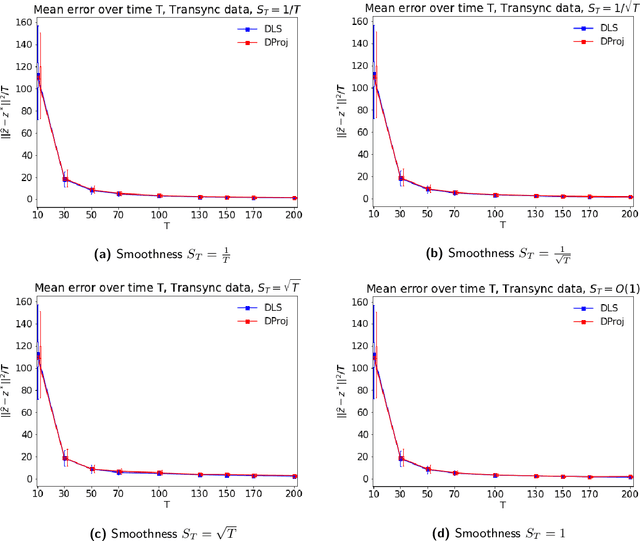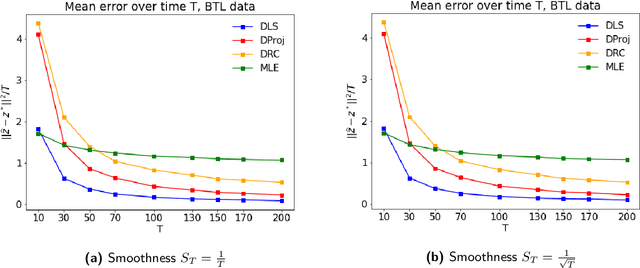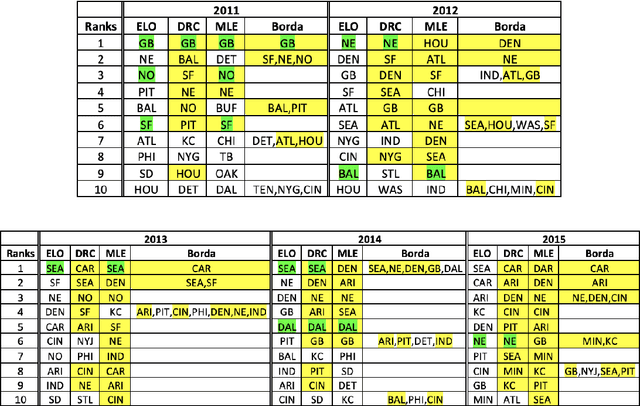Eglantine Karlé
Dynamic Ranking and Translation Synchronization
Jul 15, 2022



Abstract:In many applications, such as sport tournaments or recommendation systems, we have at our disposal data consisting of pairwise comparisons between a set of $n$ items (or players). The objective is to use this data to infer the latent strength of each item and/or their ranking. Existing results for this problem predominantly focus on the setting consisting of a single comparison graph $G$. However, there exist scenarios (e.g., sports tournaments) where the the pairwise comparison data evolves with time. Theoretical results for this dynamic setting are relatively limited and is the focus of this paper. We study an extension of the \emph{translation synchronization} problem, to the dynamic setting. In this setup, we are given a sequence of comparison graphs $(G_t)_{t\in \mathcal{T}}$, where $\mathcal{T} \subset [0,1]$ is a grid representing the time domain, and for each item $i$ and time $t\in \mathcal{T}$ there is an associated unknown strength parameter $z^*_{t,i}\in \mathbb{R}$. We aim to recover, for $t\in\mathcal{T}$, the strength vector $z^*_t=(z^*_{t,1},\dots,z^*_{t,n})$ from noisy measurements of $z^*_{t,i}-z^*_{t,j}$, where $\{i,j\}$ is an edge in $G_t$. Assuming that $z^*_t$ evolves smoothly in $t$, we propose two estimators -- one based on a smoothness-penalized least squares approach and the other based on projection onto the low frequency eigenspace of a suitable smoothness operator. For both estimators, we provide finite sample bounds for the $\ell_2$ estimation error under the assumption that $G_t$ is connected for all $t\in \mathcal{T}$, thus proving the consistency of the proposed methods in terms of the grid size $|\mathcal{T}|$. We complement our theoretical findings with experiments on synthetic and real data.
Dynamic Ranking with the BTL Model: A Nearest Neighbor based Rank Centrality Method
Sep 28, 2021


Abstract:Many applications such as recommendation systems or sports tournaments involve pairwise comparisons within a collection of $n$ items, the goal being to aggregate the binary outcomes of the comparisons in order to recover the latent strength and/or global ranking of the items. In recent years, this problem has received significant interest from a theoretical perspective with a number of methods being proposed, along with associated statistical guarantees under the assumption of a suitable generative model. While these results typically collect the pairwise comparisons as one comparison graph $G$, however in many applications - such as the outcomes of soccer matches during a tournament - the nature of pairwise outcomes can evolve with time. Theoretical results for such a dynamic setting are relatively limited compared to the aforementioned static setting. We study in this paper an extension of the classic BTL (Bradley-Terry-Luce) model for the static setting to our dynamic setup under the assumption that the probabilities of the pairwise outcomes evolve smoothly over the time domain $[0,1]$. Given a sequence of comparison graphs $(G_{t'})_{t' \in \mathcal{T}}$ on a regular grid $\mathcal{T} \subset [0,1]$, we aim at recovering the latent strengths of the items $w_t \in \mathbb{R}^n$ at any time $t \in [0,1]$. To this end, we adapt the Rank Centrality method - a popular spectral approach for ranking in the static case - by locally averaging the available data on a suitable neighborhood of $t$. When $(G_{t'})_{t' \in \mathcal{T}}$ is a sequence of Erd\"os-Renyi graphs, we provide non-asymptotic $\ell_2$ and $\ell_{\infty}$ error bounds for estimating $w_t^*$ which in particular establishes the consistency of this method in terms of $n$, and the grid size $\lvert\mathcal{T}\rvert$. We also complement our theoretical analysis with experiments on real and synthetic data.
 Add to Chrome
Add to Chrome Add to Firefox
Add to Firefox Add to Edge
Add to Edge